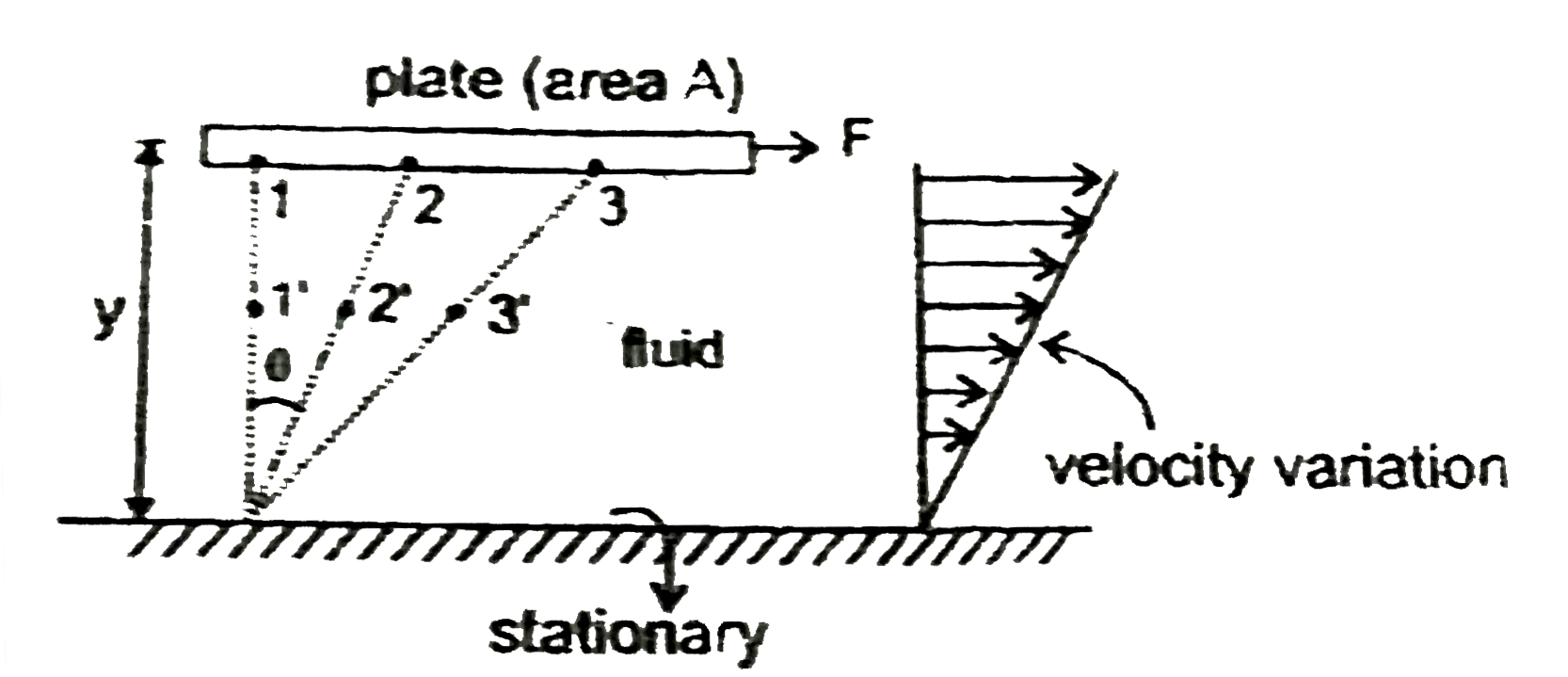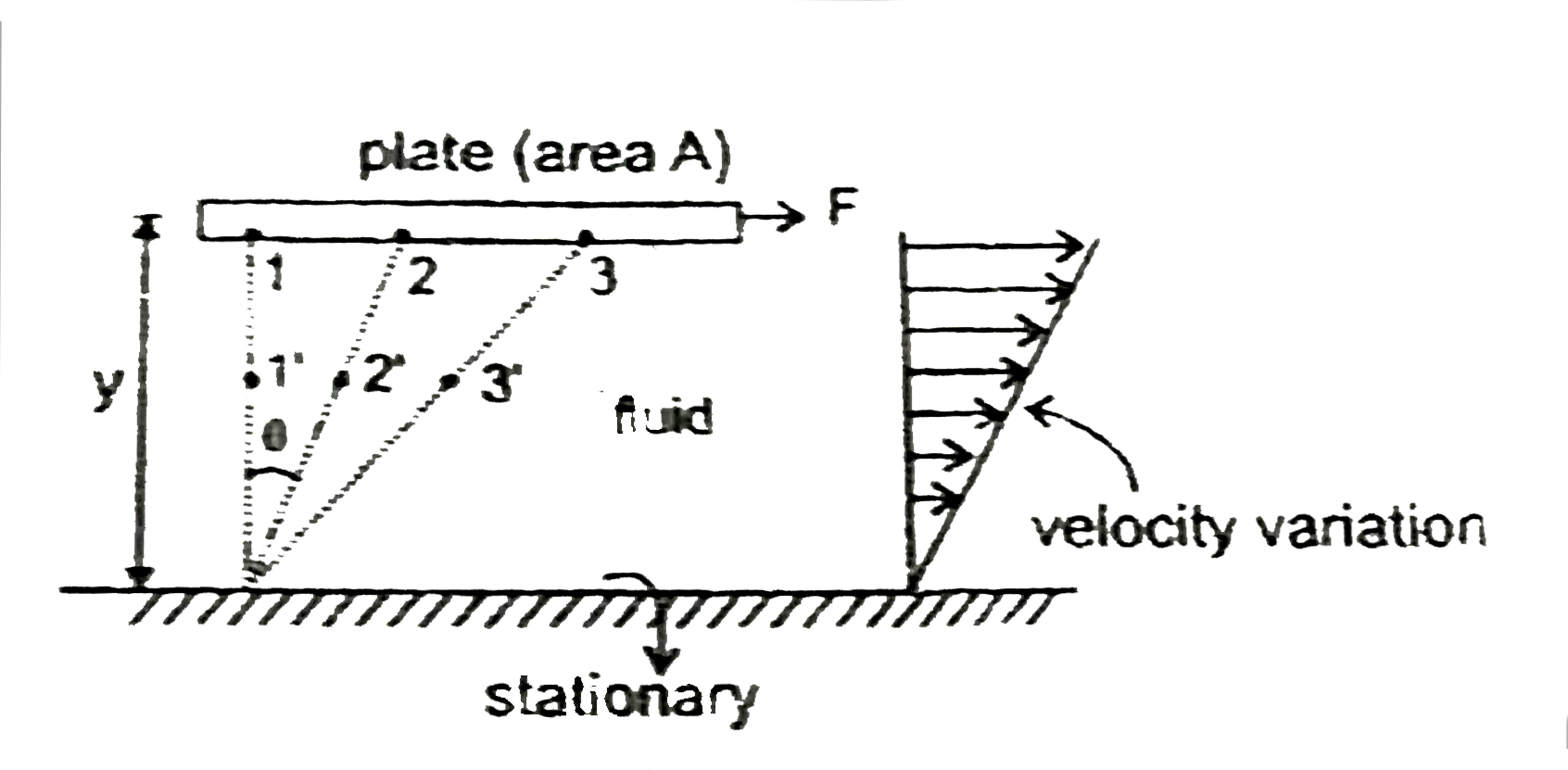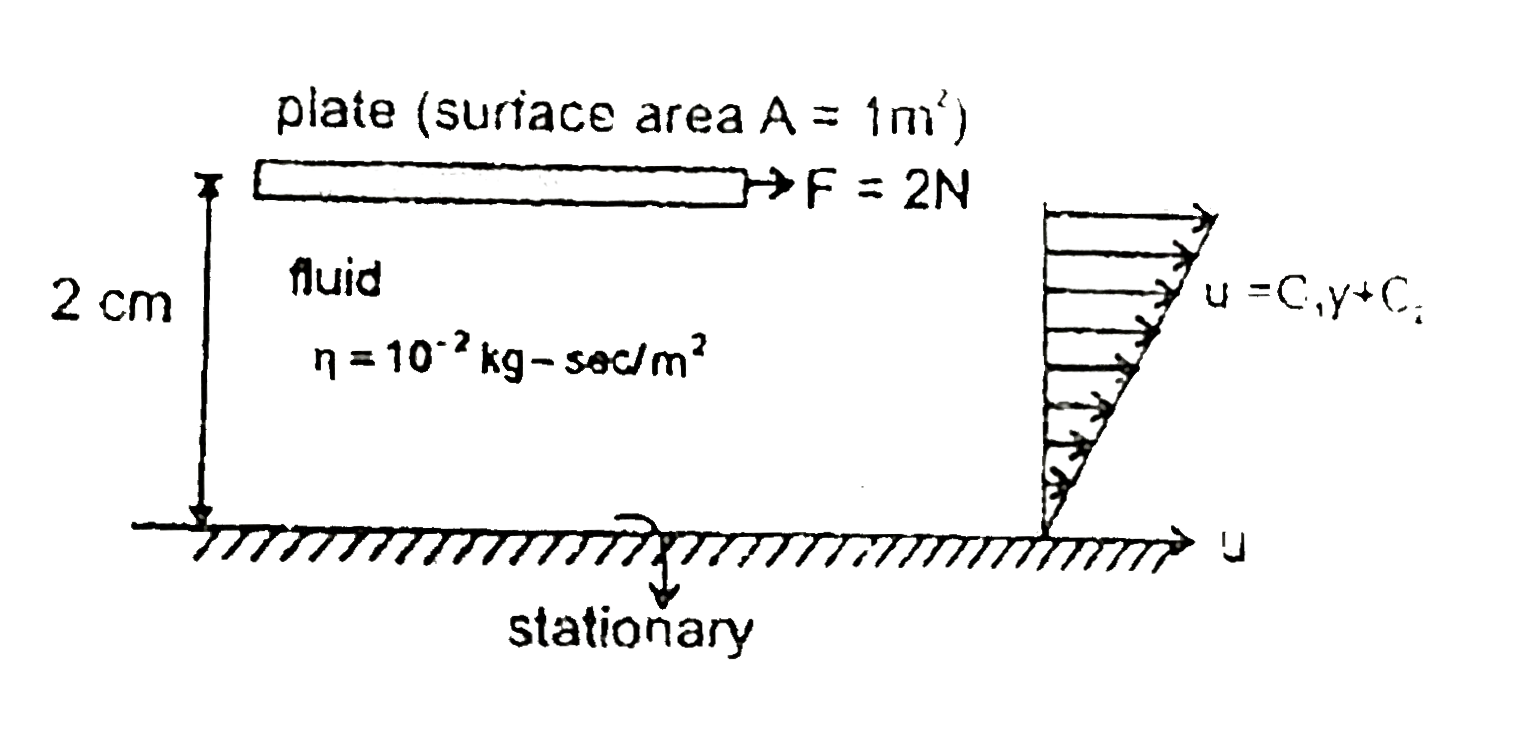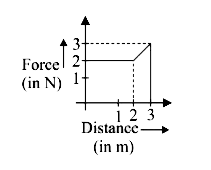Viscosity is the property of fluid by virtue of which fluid offers resistance to deformation under the influence of a tangential force.

In the given figure as the the plate moves the fluid particle at the surface moves from position to and so on, but particles at the bottom boundry remain stationary. if the gap between palte and bottom boundary is small, fluid particles in between plate and bottom moves with velocities as shown by linear velocity distribution curve otherwise the velocity distribution may be parabolic. As per Newton's law of viscity the tangential force is related to time rate of deformation -
but
then coefficient of viscosity
for non-linear velocity distribution -
where or is known as velocity gradiant.
The velocity gradient just near the bottom boundary is equal to -
zero
The correct Answer is:A
Step by step video, text & image solution for Viscosity is the property of fluid by virtue of which fluid offers resistance to deformation under the influence of a tangential force. In the given figure as the the plate moves the fluid particle at the surface moves from position 1 to 2 and so on, but particles at the bottom boundry remain stationary. if the gap between palte and bottom boundary is small, fluid particles in between plate and bottom moves with velocities as shown by linear velocity distribution curve otherwise the velocity distribution may be parabolic. As per Newton's law of viscity the tangential force is related to time rate of deformation - (F)/(A) alpha (d' theta)/(dt) but y = (d' theta)/(dt) = u, (d' theta)/(dt) = (u)/(y) then F = eta A(u)/(y), eta = coefficient of viscosity for non-linear velocity distribution - F = eta A(du)/(dy) where (u)/(y) or (du)/(dy) is known as velocity gradiant. The velocity gradient just near the bottom boundary is equal to - by Physics experts to help you in doubts & scoring excellent marks in Class 11 exams.
Topper's Solved these Questions
- BOOK - RESONANCECHAPTER - ELASTICITY AND VISCOCITYEXERCISE - Exercise- 3 PART - I7videos
ELASTICITY AND VISCOCITY
- BOOK - RESONANCECHAPTER - ELASTICITY AND VISCOCITYEXERCISE - Exercise- 3 PART - IV9videos
ELASTICITY AND VISCOCITY
- BOOK - RESONANCECHAPTER - ELASTICITY AND VISCOCITYEXERCISE - Exercise- 2 PART - II8videos
ELASTICITY AND VISCOCITY
- BOOK - RESONANCECHAPTER - DAILY PRACTICE PROBLEMSEXERCISE - dpp 92 illustration2videos
DAILY PRACTICE PROBLEMS
- BOOK - RESONANCECHAPTER - ELECTROMAGNETIC INDUCTIONEXERCISE - Exercise43videos
ELECTROMAGNETIC INDUCTION
Similar Questions
Knowledge Check
- Question 1 - Select One
Viscosity is the property of fluid by virtue of which fluid offers resistance to deformation under the influence of a tangential force.

In the given figure as the the plate moves the fluid particle at the surface moves from position 1 to 2 and so on, but particles at the bottom boundry remain stationary. if the gap between palte and bottom boundary is small, fluid particles in between plate and bottom moves with velocities as shown by linear velocity distribution curve otherwise the velocity distribution may be parabolic. As per Newton's law of viscity the tangential force is related to time rate of deformation -
FAαd'θdt but y=d'θdt=u,d'θdt=uy
then F=ηAuy,η= coefficient of viscosity
for non-linear velocity distribution -
F=ηAdudy
where uy or dudy is known as velocity gradiant.
The velocity gradient just below the plate, in above problem is equal to - (per second)AzeroB100C500D200 - Question 2 - Select One
Viscosity is the property of fluid by virtue of which fluid offers resistance to deformation under the influence of a tangential force.

In the given figure as the the plate moves the fluid particle at the surface moves from position 1 to 2 and so on, but particles at the bottom boundry remain stationary. if the gap between palte and bottom boundary is small, fluid particles in between plate and bottom moves with velocities as shown by linear velocity distribution curve otherwise the velocity distribution may be parabolic. As per Newton's law of viscity the tangential force is related to time rate of deformation -
FAαd'θdt but yd'θdt=u,d'θdt=uy
then F=ηAuy,η= coefficient of viscosity
for non-linear velocity distribution -
F=ηAdudy
where uy or dudy is known as velocity gradiant.
In previous question the value of constant speed of palte (m/sec.) is equal toA0B4C2D1 - Question 3 - Select One
Viscosity is the property of fluid by virtue of which fluid offers resistance to deformation under the influence of a tangential force.

In the given figure as the the plate moves the fluid particle at the surface moves from position 1 to 2 and so on, but particles at the bottom boundry remain stationary. if the gap between palte and bottom boundary is small, fluid particles in between plate and bottom moves with velocities as shown by linear velocity distribution curve otherwise the velocity distribution may be parabolic. As per Newton's law of viscity the tangential force is related to time rate of deformation -
FAαd'θdt but y=d'θdt=u,d'θdt=uy
then F=ηAuy,η= coefficient of viscosity
for non-linear velocity distribution -
F=ηAdudy
where uy or dudy is known as velocity gradiant.
If velocity distribution is given as (parabolic)
u=c1y2+c2y+c3
 For the same force of 2N and the speed of the plate 2m/sec, the constant C1,C2 & C3 are A200,200,0B5000,200,0C5000,0,0D500,200,0
For the same force of 2N and the speed of the plate 2m/sec, the constant C1,C2 & C3 are A200,200,0B5000,200,0C5000,0,0D500,200,0
Viscosity is the property of fluid by virtue of which fluid offers resistance to deformation under the influence of a tangential force.

In the given figure as the the plate moves the fluid particle at the surface moves from position 1 to 2 and so on, but particles at the bottom boundry remain stationary. if the gap between palte and bottom boundary is small, fluid particles in between plate and bottom moves with velocities as shown by linear velocity distribution curve otherwise the velocity distribution may be parabolic. As per Newton's law of viscity the tangential force is related to time rate of deformation -
FAαd'θdt but y=d'θdt=u,d'θdt=uy
then F=ηAuy,η= coefficient of viscosity
for non-linear velocity distribution -
F=ηAdudy
where uy or dudy is known as velocity gradiant.
In the given figure if force of 2N required to maintain constant velocity of plate, the value of constant C1,&C2 are -
 View Solution
View SolutionThe path of a particle moving under the influence of a force fixed in magnitude and direction is [
View SolutionViscosity of the fluids is analogous to
View SolutionIn amniocentesis, the fluid is takes from
View SolutionA particle moves in one dimension from rest under the influence of a force that varies with the distance travelled by the particle as shown in the figure. The kinetic energy (in J) of the particle after it has travelled 3 m is ___________
 View Solution
View Solution

